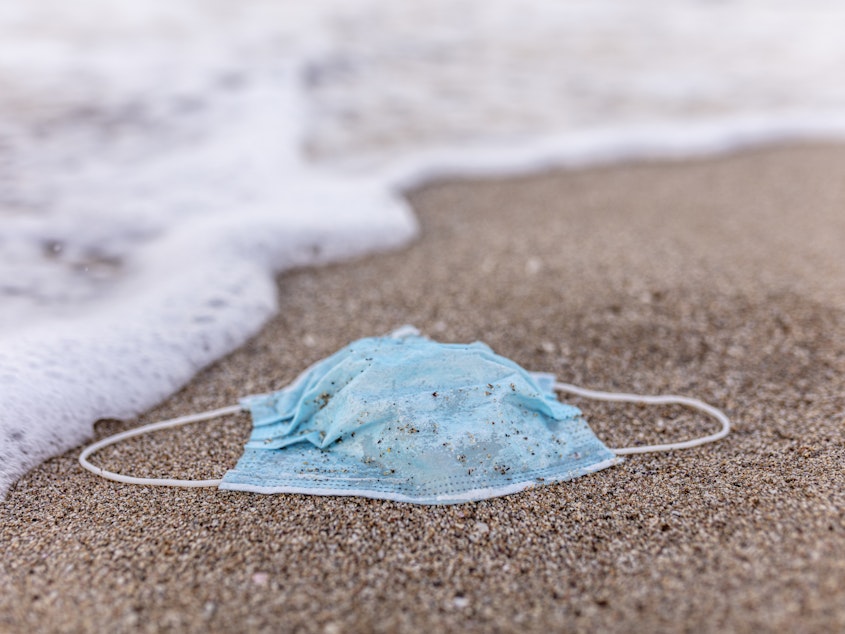The CDC sees signs of a late summer COVID wave

Yet another summer COVID wave may have started in the U.S., according to the Centers for Disease Control and Prevention.
"After roughly six, seven months of steady declines, things are starting to tick back up again," Dr. Brendan Jackson, the CDC's COVID-19 Incident Manager, tells NPR.
The amount of virus being detected in wastewater, the percentage of people testing positive for the virus, and the number of people seeking care for COVID at emergency rooms all started increasing in early July, Jackson says.
"We've seen the early indicators go up for the past several weeks and just this week for the first time in a long time we've seen hospitalizations tick up as well," Jackson says. "This could be the start of a late summer wave."
Hospitalizations jumped 10% to 7,109 for the week ended July 15, from 6,444 the previous week, according to the latest CDC data.
Sponsored
The increases vary around the country, with the virus appearing to be spreading the most in the Southeast and the least in the Midwest, Jackson says.
Rise in cases looks like a jump at the end of ski slope
But overall, the numbers remain very low — far lower than the last three summers.
"If you sort of imagine the decline in cases looking like a ski slope — going down, down, down for the last six months-- we're just starting to see a little bit of an almost like a little ski jump at the bottom," Jackson says.
Most of the hospitalizations are among are older people. And deaths from COVID are still falling — in fact deaths have fallen to the lowest they've been since the CDC started tracking them, Jackson says. That could change in the coming weeks if hospitalizations keep increasing, but that's not an inevitability, Jackson says.
Sponsored
So the CDC has no plans to changing recommendations for what most people should do, like encourage widescale masking again.
"For most people, these early signs don't need to mean much," he says.
Others agree.
"It's like when meteorologists are watching a storm forming offshore and they're not sure if it will pick up steam yet, or if it will even turn towards the mainland, but they see the conditions are there and are watching closely," says Caitlin Rivers, an epidemiologist at the Johns Hopkins Bloomberg School of Public Health.
Immunity from vaccinations and previous infections helps
Sponsored
Even if infections, emergency visits and hospitalization continue to rise to produce another wave, most experts don't expert a surge would be anywhere as severe as previous summers, largely because of the immunity people have from previous infections and vaccinations.
"We're in pretty good shape in terms of immuity. The general population seems to be in a pretty good place," says Dr. Celine Gounder, an infectious disease specialist at New York University and senior fellow at KFF Health.
Some are skeptical the country will see a summer wave of any significance.
"Right now I don't see anything in the United States that supports that we're going to see a big surge of case over the summer," says Michael Osterholm, who runs the Center for Infectious Disease Research and Policy at the University of Minnesota.
Right now the CDC says people should should continue to make individual decisions about whether to mask up while doing things like traveling or going to crowded places.
Sponsored
Older people remain at higher risk
People at high risk for COVID complications, such as older people and those with other health problems, should keep protecting themselves. That means making sure they're up to date on their vaccines, testing if they think they get sick, and getting treated fast if they become infected, doctors say.
"It's always a changing situation. People are become newly susceptible every day. People are aging into riskier age brackets. New people are being born," says Jennifer Nuzzo, who runs the Pandemic Center at the Brown School of Public Health. "The work of protecting people from this virus will continue for as long as this virus continues to circulate on this planet, and I don't foresee it going away for the foreseeable future."
Scientists and doctors think there will be another COVID wave this fall and winter that could be significant. As a result, the Food and Drug Administration is expected to approve a new vaccine in September to bolster waning immunity and try to blunt whatever happens next winter.
Some projections suggest COVID could be worse than a really bad flu season this year and next, which would mean tens of thousands of people would die from COVID annually.
Sponsored
"It will still be in the top 10 causes of death, and I suspect that COVID will remain in the top 10 or 15 causes of death in the United States," says Justin Lessler, an epidemiologist at University of North Carolina, Chapel Hill, who helps run the COVID-19 Scenario Modeling Hub. [Copyright 2023 NPR]



